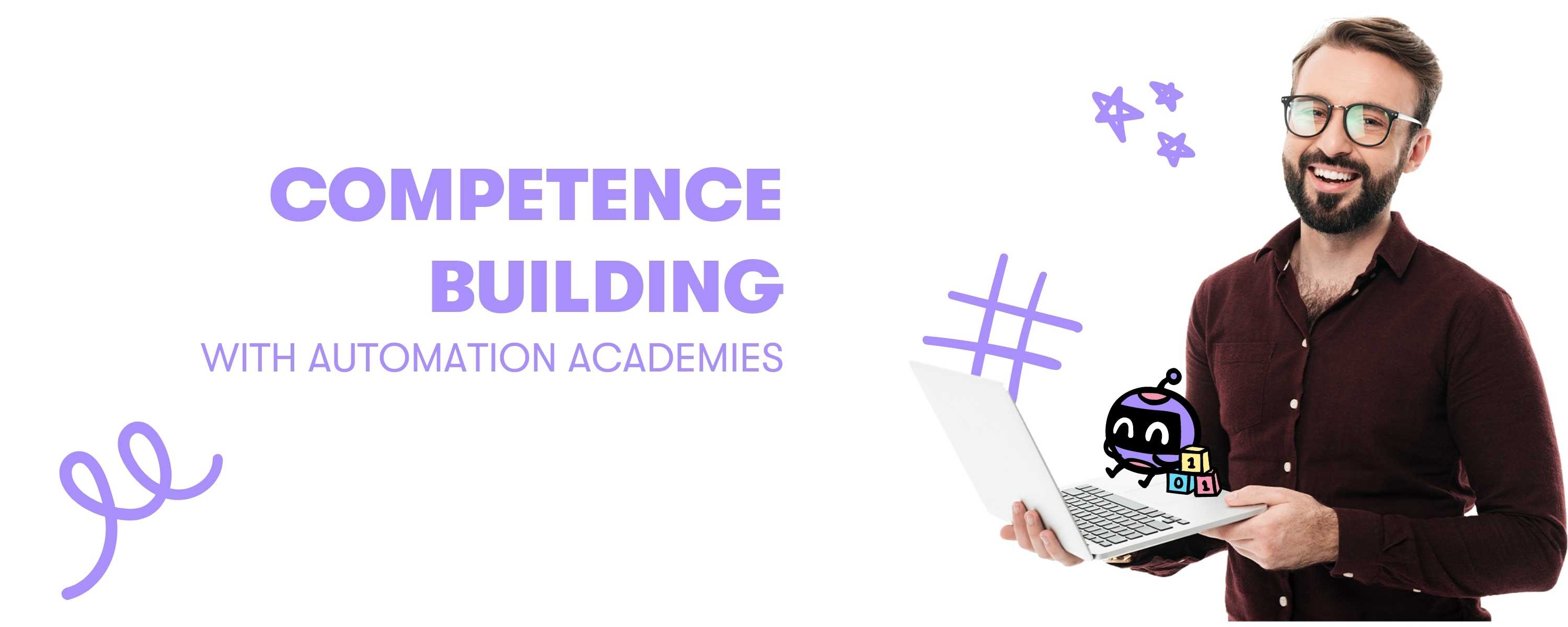A Center of Excellence is not an invention of the automation industry, but it is an important building block. Anyone who reads up on process automation these days cannot avoid one term: the Center of Excellence (CoE) - the cornerstone of successful, scalable process automation.
As such, it's no wonder that building a Center of Excellence is becoming increasingly popular among automation-savvy companies, and more and more organizations are adopting the CoE. So, what is the role of a Center of Excellence in an automation strategy? Keep reading to find out!

What is a Center of Excellence?
Centers of Excellence are not new. Already in the last decades, CoEs - also known as Knowledge Centers - have been used for various purposes to share accumulated knowledge in different enterprise areas, such as marketing, data and analytics, cloud strategy, HR, CRM, and more. Even before RPA and the automation hype, centers of excellence were used to handle specific complex business tasks efficiently and effectively.
CoEs are made up of individuals with specialized expertise in specific areas, who work together to develop and promote best practices across the company. CoEs are standalone units designed to provide expert guidance to teams or to deliver specific business services. CEOs who invest in a Center of Excellence are sending a clear message that they want to drive a strategically relevant issue. For process automation, today this is more relevant than ever, especially when you consider its huge and often criminally neglected potential.
CoEs are Essential for Automation Scaling
Providers and consulting firms recognized the value and opportunity presented by a center of excellence for establishing sustainable process automation solutions. They quickly embraced this concept because the complexities of RPA and similar technologies only become evident after multiple bots have been deployed.
At that point, those responsible realize that the bots are not functioning smoothly and cannot be scaled effectively. In the realm of process automation, a Center of Excellence now plays a crucial role. It serves as a test lab for implementing and testing initial RPA solutions, setting standards for the development and implementation of automation solutions, overseeing the company-wide rollout of RPA, and scaling complex projects for long-term success. Essentially, the Center of Excellence is the go-to department for comprehensive and efficient automation services across the company.
How a Center of Excellence Enables Intelligent Automation
This is all the more important because this technology will continue to develop dynamically in the direction of Intelligent Automation. An established Center of Excellence simplifies the further development and implementation of automation technologies, such as Robotic Process Automation or automation with a so-called Integrated Platform as a Service (iPaaS). In addition, CoEs play a vital role in expediting the delivery of advanced, AI-driven technologies while consistently enhancing the level of automation. They oversee the entire automation lifecycle from a central hub. This includes identifying processes suitable for automation, evaluating them, developing standardized procedures for implementation and upkeep, and managing an extensive landscape of bots within the automation ecosystem.

How to Develop a Center of Excellence
The decision-making process surrounding the establishment of a Center of Excellence (CoE) is driven by two key factors: where to locate the CoE within the organization and whether to build it internally or procure it as a specialized service from an external provider. Another important aspect is whether the CoE will be run as a cost center or as a profit center. In this section, we explore all three issues and the possible approaches.
It's not possible to make a general statement about the best location for a Center of Excellence. The form under which a Center of Excellence is embedded in an organization depends on the structure of the company, as well as the goals it is pursuing with a Center of Excellence. Strongly centralized organizations will rely on a centralized Center of Excellence to achieve the greatest benefit and impact, while regionally distributed, decentralized organizations prefer a CoE structure that mimics this.
Decentralized CoE
A decentralized Center of Excellence operates in close proximity to individual business units, resulting in the existence of multiple CoEs. This setup capitalizes on the wealth of process knowledge within each unit, leading to swift achievements. The close interconnection facilitates the exchange of knowledge and enables a high level of agility and adaptability.
A decentralized Center of Excellence is particularly suitable when departments have distinct requirements. However, the decentralized structure limits central control options, making it challenging to establish cross-company transparency and achieve scalability of RPA and AI implementation across different business units. Furthermore, a decentralized CoE can give rise to intricate automation silos, leading to redundant efforts and increased costs. across different business units.
Centralized CoE
Central CoEs are usually attached to IT or act as shared service centers. All automation projects are bundled in a central location, which increases transparency, enables central governance and facilitates the scalability of automation across the various business units.
Setting up a central CoE does require more effort in planning and internal coordination. However, having a centralized location simplifies the operation and maintenance of automation solutions and the standardization of automation processes, while also reducing costs. The success of a centralized CoE largely depends on maintaining contact and good internal communication with the business units that are its internal customers.
Hybrid CoE
Hybrid CoEs offer the best of both worlds. For example, a larger CoE acts as a central hub that controls decentralized CoEs docked to the business side. Despite centralized control, this approach offers room for individual solutions and is suitable for organizations that have individual business units with particularly high automation potential.
Make or Buy?
Opting for an external provider is often motivated by the desire to centralize the setup at a reduced cost, as standardizing work for multiple customers typically leads to lower market prices compared to internal personnel and operational costs. While the economic incentives are understandable, it is crucial not to overlook certain factors.
An external provider will not share the same vision of the business model nor possess a deep understanding of the company's organizational and strategic nuances. Dealing with a diverse customer base, the provider may struggle to adapt its service to the specific requirements of each individual customer.
On the other hand, an in-house CoE brings inherent dedication and loyalty to the table, along with greater transparency. Moreover, the CoE's in-depth understanding of business processes and data leads to optimized delivery and valuable insights. The direct and seamless communication between the CoE and business units, as clients of the automation solution, facilitates problem-solving without fear of jeopardizing the long-term relationship due to potentially unfavorable information or results. Outsourcing a CoE introduces the risk of losing such advantages.
Centers of Excellence cost money
A CoE requires financial resources for the necessary technical resources, operations and the salaries of qualified employees to guarantee smooth operations. To put it in a simple formula: CoEs are supposed to continuously change processes and workflows through automation from the point of view of effectiveness and efficiency. But change costs money. Economically poorly designed CoEs can end up costing more money than they benefit. The question of a solid financing structure for the CoE is therefore of central importance. For management, this means deciding whether to run the CoE as a cost or profit center. In doing so, it must always keep in mind that in many cases a CoE increases costs in favor of using knowledge and experience to reduce overall costs.
Cost Center
In a cost center, a CoE is given a budget that is to be used as sensibly as possible to fulfill its task or certain services. This means that automation projects that appear to make sense are implemented regardless of the costs. This way, even small projects have a chance of being implemented. However, since working profitably is not at the forefront of the CoE as a cost center, it can sometimes lead to a CoE operating at a loss. To prevent this, the management could decide to make the cost-benefit aspect the sole and decisive criterion for the realization of automation projects.
Profit Center
Managed as a profit center, the CoE must achieve certain sales, productivity and profit targets or maximize performance accordingly. A Center of Excellence is managed as an independent and autonomous unit that has a great deal of freedom, but is measured by results and is ultimately financed through profit. As long as a CoE operates profitably as a profit center, management has created a cost-neutral opportunity for company-wide process automation. However, the freedom also includes the fact that external sales can be generated in addition to internal company sales. However, the high degree of market proximity and the compulsion to make a profit are associated with the risk that the CoE will prioritize external orders over internal projects because of the higher market price that can be achieved, or that it will look for other sources of funding such as training and consulting services for other companies or corporate partnerships.
What is the Structure of a CoE in Automation?
The heart of a CoE is the team of experts. The size of the team ultimately depends on the size of the company and the scope and goals of the planned automation. At the minimum, a CoE can consist of a small team of only two or three people. It can be set up for just one specialist department or for different departments.
The key aspect is that all relevant core competencies needed for a successful RPA rollout and operation are represented. Before implementing a CoE, it's important to consider which competencies and experts are already available in-house and whether they can be inspired for the Center of Excellence. Depending on the resources available, roles and responsibilities can also be bundled and assumed by one person, but this is contingent on the company's internal structure.

Competence can be built up
A lack of automation expertise in the workforce is no reason to bury the idea of a CoE. Automation Academies such as Bots & People offer competent training, education and continuing education to prepare employees for the various roles, to impart broad know-how in the area of process automation and process mining as well as a corresponding digital mindset.
Overall, three main areas should be covered with appropriately qualified personnel:
- RPA Development - responsible for process identification and validation, process documentation and optimization, RPA development,.
- RPA Operations & Support - responsible for RPA infrastructure & operations, performance management, technical support.
- Communication & Training - responsible for internal communication, change management & training .
In order to complete the tasks in a CoE, the Automation Developer, the Automation Strategist, an Automation Architect and the Automation Change Manager work closely together. Ideally, each department also has an Automation Champion who is very familiar with the operational execution of the respective departmental processes. The champion identifies the processes in his department that can be automated and makes suggestions for process automation. In general, employees look forward to a potential internal career as an Automation Specialist. There are different tracks available for this:
The Automation Sponsor
At its best, the Automation Sponsor is a leader who understands the transformative forces of automation technology and has the authority to legitimize and drive the investment of time and money with a compelling value proposition and visionary business case.
The Automation Strategist
The Automation Strategist knows the latest relevant automation and process mining technologies. He wears the hat for all automation projects of the business department and closes the gap between the business department and a Center of Excellence as the executing organization of automation within the company.
The Automation Developer
The Automation Developer is a trained RPA developer with extensive automation understanding, ranging from RPA development - building software bots - to cloud automation and API development (interface programming). He implements the automation of the processes.
The Automation Architect
The Automation Architect designs the necessary IT infrastructure for the automation projects and keeps an eye on the costs for tools and technologies. This requires a deep understanding of the entire spectrum of IT operations to ensure the availability, efficiency and performance of the IT infrastructure processes and services.
The Automation Change Manager
The Automation Change Manager carries the change initiatives from the CoE to the business departments and helps the business departments with the transformation. Depending on the size of the CoE, the team may also include an RPA Infrastructure Engineer, an RPA Supervisor and/or an RPA Service Supporter.
Addressing Challenges in CoE Set Up
While establishing a Center of Excellence may appear promising, it is essential to acknowledge the potential challenges that can lead to the failure of a CoE project. One significant factor is complexity, as a CoE involves a combination of people, processes, and technology. The complexity of setting up a CoE begins with process selection, which often lacks proper execution. Employees and staff may rush to automate processes they dislike, disregarding whether it is sensible or not.
Furthermore, managers sometimes focus solely on reducing full-time equivalents (FTE) without considering the importance of defining clear key performance indicators for process performance, business benefits, and ROI calculations. Initiating an RPA project without sufficient management buy-in, particularly without a high-level RPA sponsor, is bound to fail because RPA impacts the entire organization.
Projects may also become overly demanding, time-consuming, and maintenance-intensive, or there may not be a sufficient number of projects to automate, resulting in underwhelming outcomes. Rushing ahead without a roadmap often leads to chaos and increased inefficiency. Finding the right balance in discussions with the IT department is crucial. While they provide the necessary RPA infrastructure, relying solely on the IT department can have detrimental consequences. They may lack a detailed understanding of processes at the granular level, including working instructions and exceptions.
Scaling Requires High-Level Support
On the strategic side, the challenge is not the implementation of an automation solution, but its scaling. Synergies must be found and, for example, a successful automation process must also be established in other areas. This requires appropriate RPA experts, as well as a clear corporate vision supported by a sponsor who drives the initiative forward. To ensure that the project is established as a company-wide strategic priority and that resources are bundled in this regard, the sponsor should occupy a high-ranking position. This is because he or she is a co-sponsor of strategic decisions and the interface to corporate management.
Keep an Eye on Tomorrow's Technology
Another challenge is that many RPA tools cannot solve more complex, cognitive tasks. This requires not only flexibility from a CoE, but also foresight to look beyond the current technological horizon and extensive automation expertise to ensure a transition to the next generation of RPA. After all, it is functions such as artificial intelligence (AI) and machine learning (ML) that make it possible to automate a variety of complex tasks. From a purely practical perspective, it also requires a professional IT support team to immediately address the potential difficulties that may arise during implementation. Only if the CoE deploys scalable, appropriately sized solutions can it keep pace with future requirements.
Too Many Processes Can Cause Bottlenecks
The success of automation is influenced not only by the quality of the processes but also by their quantity. Having too few eligible processes for automation can be a limitation, but the opposite can also pose challenges. When numerous processes are identified for automation, it becomes crucial to manage them effectively.
The number of automation projects implemented depends primarily on the available resources. However, even with the necessary quality and automation potential, it is often not feasible to automate all identified processes simultaneously. Therefore, it is advisable to prioritize the selected processes. Two key questions prove to be highly beneficial in this regard. First, what is the importance of addressing the problems through automation within the overall business strategy? Second, what are the benefits that can be achieved by automating each process? By answering these questions, a prioritized overview of the processes to be automated can be obtained, often depicted in a visually accessible heat map format.
Conclusion
A Center of Excellence is an organizational entity that embodies a set of capabilities explicitly identified by business leaders and managers as an important source of value creation, with the intention that these capabilities are used by and/or passed on to other parts of the organization. It facilitates the work of other business units and contributes to the progress of the entire organization. This also makes a CoE a component to be carefully planned when building a robust RPA or automation program. However, many aspects must be considered before deployment. Companies implementing RPA or considering it should especially think of how a CoE can take advantage of the ever-expanding scope of AI and intelligent automation products to ensure sustainable and future-proof operations.









